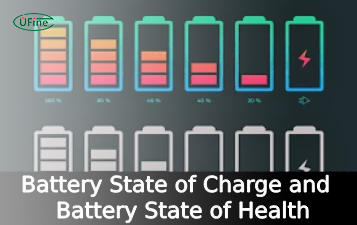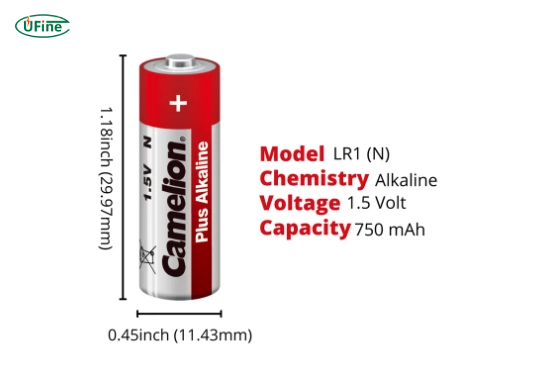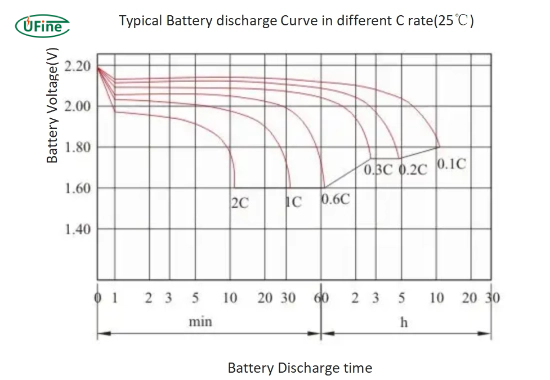
- Part 1. What is an N-size battery?
- Part 2. What are the dimensions of an N-size battery?
- Part 3. What is the voltage and capacity of an N-size battery?
- Part 4. What chemistries are used in N-size batteries?
- Part 5. Price comparison of N-size battery chemistries
- Part 6. Key differences between alkaline and lithium N-size batteries
- Part 7. What are N-size batteries used for?
- Part 8. How does an N-size battery compare to similar batteries?
- Part 9. Are N-size batteries rechargeable?
- Part 10. How long does an N-size battery last?
- Part 11. Can N-size batteries leak or be dangerous?
- Part 12. Where can you buy N-size batteries?
- Part 13. FAQs about N-size batteries
An N-size battery is a compact cylindrical battery used in small electronic devices like cameras, medical tools, and remote controls. It is also known by names such as LR1, E90, or MN9100. This battery is valued for its small size, reliable voltage, and long shelf life.
If you’re wondering what an N-size battery is, how big it is, what it is made of, and what you can use it for, this guide will answer all your questions. Whether you’re buying a replacement or just curious, this complete article will help you understand everything about the N-size battery.
Part 1. What is an N-size battery?
An N-size battery is a small, cylindrical, single-cell battery. It looks similar to an AAA battery but is shorter and thicker. This size is uncommon in everyday household items but is essential for many niche devices requiring compact power sources.
It operates at 1.5 volts in most non-rechargeable versions and is available in different chemistries such as alkaline, zinc-carbon, lithium, and nickel-metal hydride (NiMH).
Part 2. What are the dimensions of an N-size battery?
The dimensions of an N-size battery are standardized, which makes it easy for manufacturers to design devices around it.
- Length: 30.2 millimeters (1.19 inches)
- Diameter: 12.0 millimeters (0.47 inches)
- Shape: Cylindrical
- Weight: Approximately 10 to 12 grams
These measurements make the N-size battery smaller than AA and AAA batteries but larger than AAAA and button cells.
Part 3. What is the voltage and capacity of an N-size battery?
The voltage and capacity of an N-size battery depend on the battery’s chemistry.
Here is a quick breakdown:
- Alkaline (LR1): 1.5 volts, 800 to 1000 mAh
- Zinc-Carbon (R1): 1.5 volts, 400 to 600 mAh
- NiMH (Rechargeable): 1.2 volts, 200 to 300 mAh
- Lithium: 1.5 to 3.0 volts depending on model, up to 1200 mAh
Milliamp-hours (mAh) measure how much energy a battery stores. More mAh means a longer-lasting battery.
Part 4. What chemistries are used in N-size batteries?
N-size batteries are available in several chemical compositions, each suited for different needs.
1. Alkaline
- Most common type
- Offers a balance between price and performance
- Good shelf life of up to 5 years
- Works well in everyday low to medium-drain devices
2. Zinc-Carbon
- Lower cost
- Lower capacity compared to alkaline
- Shorter shelf life and not suitable for high-drain devices
- Often used in simple devices like clocks
3. Nickel-Metal Hydride (NiMH)
- Rechargeable
- Lower voltage (1.2 volts)
- Shorter runtime per charge
- Can be reused hundreds of times
- More environmentally friendly
4. Lithium
- Higher energy density
- Lightweight
- Performs well in extreme temperatures
- Very long shelf life, up to 10 years
- Ideal for high-drain or sensitive devices
Part 5. Price comparison of N-size battery chemistries
Here’s a price comparison table showing the average cost per battery based on chemistry:
| Chemistry | Average Price (USD) | Rechargeable | Shelf Life | Best For |
|---|---|---|---|---|
| Alkaline (LR1) | $1.50 – $2.50 | No | 4 to 5 years | General use, remote controls |
| Zinc-Carbon (R1) | $0.80 – $1.20 | No | 1 to 2 years | Clocks, basic electronics |
| NiMH (Rechargeable) | $3.00 – $5.00 | Yes | 3 to 5 years | Frequent use, eco-conscious |
| Lithium | $2.50 – $4.00 | No | Up to 10 years | Medical devices, cold areas |
Prices vary based on brand and bulk purchasing, but this table gives a useful comparison.
Part 6. Key differences between alkaline and lithium N-size batteries
Alkaline and lithium N-size batteries are popular but perform differently in real-world situations.
Alkaline
- Stable voltage output
- Affordable and widely available
- Performs well in low to medium-drain devices
- May lose power in extreme cold
- Creates more waste if not recyclable
Lithium
- Higher capacity and energy density
- Works in both high and low temperatures
- Lightweight and leak-resistant
- More expensive
- Lasts longer in high-drain devices
In short, lithium batteries last longer and perform better under stress, while alkaline batteries are more cost-effective for everyday use.
Part 7. What are N-size batteries used for?
N-size batteries are used in compact, low to medium-drain electronic devices. They are valued for their size, stable voltage, and ability to operate in multiple environments.
Common applications include:
- Digital thermometers
- Blood pressure monitors
- Miniature flashlights
- Laser pointers
- Garage door remotes
- Clocks and timers
- Wireless microphones
- Medical devices like glucose meters
These batteries are often chosen when space is limited and performance is critical.
Part 8. How does an N-size battery compare to similar batteries?
Here’s a comparison of N-size batteries with other common types:
| Battery Type | Length (mm) | Diameter (mm) | Voltage | Rechargeable | Common Uses |
|---|---|---|---|---|---|
| AAA | 44.5 | 10.5 | 1.5 | Yes | Toys, remotes, flashlights |
| AA | 50.5 | 14.5 | 1.5 | Yes | Cameras, clocks, radios |
| N-size | 30.2 | 12.0 | 1.5 | Some | Medical tools, remotes |
| AAAA | 42.5 | 8.3 | 1.5 | Some | Stylus pens, headlamps |
The N-size battery is a unique fit. Due to size and voltage differences, it cannot replace other types.
Part 9. Are N-size batteries rechargeable?
N-size batteries are available in rechargeable versions, mainly using NiMH chemistry. These batteries can be recharged hundreds of times, making them a good choice for people who want to reduce waste and save money over time.
However, you need a compatible charger and must ensure your device supports NiMH cells’ slightly lower voltage (1.2 volts).
Rechargeable N batteries are perfect for:
- Wireless electronics
- Frequent-use devices
- Eco-friendly consumers
Part 10. How long does an N-size battery last?
Battery life depends on several factors:
- Chemistry: Lithium batteries last longer than alkaline or carbon-zinc batteries
- Device type: High-drain devices like flashlights use more power
- Usage: Frequent use will drain the battery faster
- Storage: High temperatures or humidity can reduce shelf life
Here’s a general idea:
- Alkaline: 2 to 6 months in regular use
- Lithium: Up to 1 year or more
- Zinc-Carbon: 1 to 3 months
- Rechargeable NiMH: 2 to 4 weeks per charge, up to 500 cycles
Always check the expiration date and store batteries in a cool, dry place.
Part 11. Can N-size batteries leak or be dangerous?
Yes, N-size batteries can leak or even explode if used improperly. This is rare but can occur under the following conditions:
- Inserted with incorrect polarity
- Attempted recharge of non-rechargeable batteries
- Exposure to heat or water
- Physical damage or corrosion
To stay safe:
- Use batteries as directed by the manufacturer
- Remove batteries from unused devices
- Avoid mixing old and new batteries
- Recycle used batteries properly
Proper handling extends battery life and protects your devices.
Part 12. Where can you buy N-size batteries?
You can purchase N-size batteries from:
- Online retailers like Amazon, eBay, and battery specialty sites
- Big box stores like Walmart, Target, and Best Buy
- Pharmacies such as CVS or Walgreens
- Electronics stores or hardware shops
When shopping, check for compatible names such as LR1, AM5, MN9100, or E90 to find the right type.
Part 13. FAQs about N-size batteries
What devices use N-size batteries?
Devices like blood pressure monitors, laser pointers, timers, and remotes often use N-size batteries.
Are N-size batteries the same as AAAA batteries?
No, N-size batteries are broader and shorter than AAAA batteries. They are not interchangeable.
Can I use AA or AAA batteries instead of N-size?
No, AA or AAA batteries are too large to fit in devices made for N-size batteries.
Is an E90 battery the same as an N-size battery?
Yes, E90 is another name for the N-size battery, especially in alkaline form.
Do rechargeable N-size batteries last as long as non-rechargeable batteries?
They offer shorter use per charge but can be reused many times, making them more cost-effective in the long run.
Related Tags:
More Articles

Battery State of Charge and Battery State of Health
Battery SoC vs. SoH explained: Learn professional methods to measure charge levels, test health status, and optimize battery performance for longer lifespan.
Difference Between 18650, 26650, and 21700 Batteries
What’s the difference between 18650, 21700, and 26650 batteries? Compare size, capacity, and performance to find the best lithium battery for your device.
LFP Battery Vs. LTO Battery: A Detailed Comparison
Compare LFP (LiFePO4) and LTO (Lithium Titanate) batteries by energy density, lifespan, safety, cost, and uses in EVs, solar storage, and backup power.
Compare 18650 battery types: Li-ion, LiFePO4, and LiPo. Key specs (voltage/capacity) and best uses for vapes, flashlights, EV batteries.
How to Distinguish Between Grade A, Grade B, and Grade C LiFePO4 cells?
Explore the differences between Grade A, B, and C LiFePO4 cells and learn how to choose the right one for electric vehicles, solar storage, or backup power.




